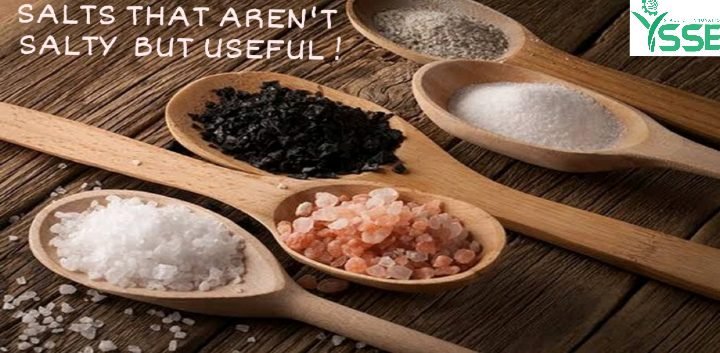Nature beholds so many mysteries. Salts are one of them. There is a wide range of salts that exist on our planet. These salts with their unique chemistry and unorthodox properties have helped humans from the beginning. Besides the table variety, which tastes salty, there are countless varieties of salt with different tastes, textures and health benefits. Whether you’re a food lover or a curious learner, come join us on this journey in which we’ll explore the world of salt.
Chemically, Salts are ionic compounds resulting from the neutralisation reaction. In the context of health and wellness, salts are important minerals that the body needs to function properly. In culinary arts, salts are essential ingredients that are used for seasoning, preserving, and enhancing the flavour of foods. And in geology, salts are minerals which result from saltwater by a process called evaporation.
Salts can be found in a variety of environments, from ancient ocean beds to modern salt flats. Not all salts are created equal. Salty or not, uses of salts are essential in many areas of daily life. In the exploration of salts, now we’ll analyse some of their chemical properties, examine their unique tastes and textures and uncover some important special uses that each salt is offering.
- Epsom salt
Epsom Salt : Also known as magnesium sulphate heptahydrate (MgSO4.7H2O). This guy comes in a variety of forms, including colourless needle-like crystals but don’t be fooled by its lack of pigment. Because it gives a bitter, salty punch. However, It has a unique scent. You will probably love it!
- A popular choice for athletes and those looking to soothe sore muscles after a workout.
- Often used in beauty and wellness products such as bath salts, foot scrubs, and face masks.
- Commonly used in gardening as a natural fertiliser for plants.
- Black salt
Black Salt : Kala Namak or Black Salt, is a staple in Indian cuisine. It has a pinkish-grey colour and a pungent sulphur smell that will definitely shake your senses. Its chemical formula is mostly sodium chloride (NaCl) but with small amounts of other minerals like sulfites and bisulfates thrown in for good measure. When it hits your tongue, you’ll taste a sour, salty sensation that’s hard to describe.
- A staple ingredient in Indian cuisine that’s used to add a distinctive umami flavour to dishes.
- Often used in Ayurveda medicine to help with digestion and respiratory issues.
- A popular vegan substitute for eggs in recipes such as tofu scrambles and vegan quiches.
- Calcium Lactate
Calcium Lactate: Ca(C3H5O3)2 is its chemical formula. It’s a white crystalline salt that’s easily soluble in water, making it a popular food additive. When you taste it, you’ll notice a mild saltiness that’s slightly sweet but not overpowering. It’s commonly used in products like cheese and baking powder.
- A common ingredient in food and beverage products that’s used as a source of calcium.
- Often used in the production of processed meats and other foods to improve texture and shelf life.
- Also used in the medical field as a treatment for calcium deficiency and certain digestive disorders.
- Borax
Na2B4O7.10H2O, aka Borax, is a white crystalline powder that’s slightly sweet on the tongue. It’s super soluble in water and has a variety of uses, from cleaning agents to flux for welding and soldering.
- A versatile cleaning agent, borax is used for laundry and household surfaces.
- As an effective insecticide, borax is used to control pests like ants and cockroaches.
- In industry, borax is used in the production of glass, ceramics, and fertilisers.
- Nitrate of Potash
Nitrate of Potash : we simply have KNO3 here. This white crystalline salt has a slightly bitter and unfamiliar salty taste. Nitre is highly soluble in water. If you’re a fan of saltier flavours, you might want to give this one a try!
- Used extensively in the production of gunpowder, fireworks, and explosives, nitre plays a key role in the defence industry.
- In the food industry, nitre is used as a preservative to prevent the spoilage of meats.
- Nitre is also used as a fertiliser to provide nitrogen to plants, promoting their growth.
- Alum
Alum : KAl(SO4)2.12H2O. Last but not the least, Alum is a jack of all trades. This white crystalline powder is odourless, but don’t let that fool you. It’s got a slightly sweet taste that’s used in everything from water purification to baking powder. You can find it in crystal form or as a powder, but one thing’s for sure, it’s versatile.
- A common pickling agent, alum is used to preserve foods like pickles and olives.
- In the paper industry, alum is used to improve ink absorption and enhance paper quality.
- In water treatment, alum is used as a flocculant to remove impurities from water, making it safer for consumption.
The versatility of salts knows no bounds, as it is being useful on a massive level in our lives. From the humble kitchen to the sterile environment of hospitals and from the rugged industrial sector to the cutting-edge scientific laboratory, salt plays a vital role in countless ways. Its ability to add flavour, preserve food and cleanse is just the tip of the iceberg. It is essential in many fields like agriculture, chemistry and manufacturing. Truly, salt may appear simple, but its importance cannot be overstated.
To read more blogs like this, click here .
Writer,
MD Rakib Rayhan
Intern, Content Writing Department,
YSSE

